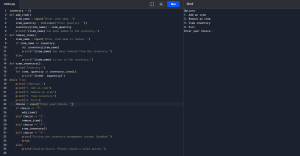An inventory system in Python is a powerful tool that helps businesses keep track of their inventory, manage expenses, improve customer satisfaction, and make informed decisions based on data.
Effective inventory management involves overseeing the movement of goods from manufacturers to warehouses, and ultimately to customers. The process includes procurement, storage, tracking, and fulfilling orders. By managing inventory correctly, a business can ensure that it always has the right products in the right quantities at the right time, while minimizing shortages or excess.
Key Features of Inventory System
An Inventory Management System in Python typically includes the following key features:
- Product Management: This feature enables users to efficiently manage product information like name, description, price, and stock quantity using powerful data structures like dictionaries in Python.
- Inventory Tracking: Real-time inventory tracking is crucial. Python automates updates for sales, returns, and restocking.
- Supplier Management: Managing relationships with suppliers is crucial. Python can help store supplier information, track orders, and manage lead times effectively.
- Order Processing: This feature streamlines purchase order creation, product receiving, and stock updates for efficient order processing.
- Reporting and Analytics: Data analytics is crucial for inventory management systems. Python’s powerful libraries, such as Pandas and Matplotlib, can be utilized to create dashboards and reports for gaining insights into inventory turnover, supplier performance, and sales trends.
Design Considerations
To build an effective Inventory Management System in Python, it’s important to consider the following design aspects:
- Database: Choose an appropriate database management system, such as SQLite, MySQL, or PostgreSQL, to store product data, inventory levels, supplier details, and transaction history. Python provides libraries like SQLite3 for easy integration.
- User Authentication: Implement strong user authentication mechanisms to safeguard sensitive inventory data and define user roles and permissions to control access.
- Scalability: Design the system to scale as your business grows. A modular architecture allows for future enhancements and increased inventory volumes.
- Security: Prioritize regular security audits to safeguard against data breaches and unauthorized access, ensuring data integrity.
Implementing an Inventory System in Python
Let’s illustrate the implementation of an Inventory Management System in Python with some practical code examples. We’ll use Python’s built-in data structures and libraries for this purpose.

INVENTORY SYSTEM IN PYTHON
The above code snippets provide a foundation for managing products, tracking inventory, and suppliers. These functions can be expanded and integrated into a user-friendly interface in a real-world implementation.
An Inventory Management System in Python is a valuable tool for businesses of all sizes to efficiently manage their inventory, reduce costs, and make informed decisions. By considering design aspects, implementing key features, and utilizing Python’s powerful libraries and data structures. You can create an effective system that streamlines your business operations and helps you stay competitive in today’s dynamic market. Whether you are managing a retail store, a warehouse, or an e-commerce platform, an Inventory Management System in Python can significantly enhance your efficiency and profitability.
| You can get this Project Code Here. |








Leave a Comment